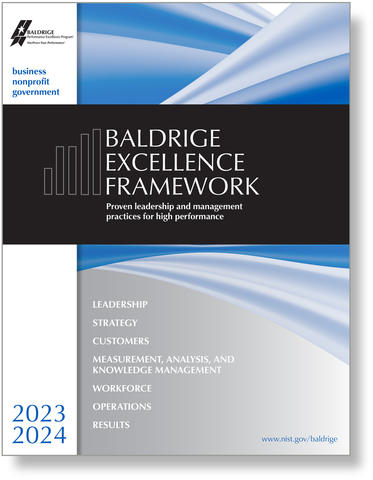Blogrige
The Official Baldrige Blog

In an earlier blog, I introduced you to Arnie Weimerskirch, a former VP of corporate quality at Honeywell and the former chair of the Baldrige Judges Panel. I recently had lunch with him and learned how he got involved with the Baldrige Program and how it impacted his career. I think it is a story worth sharing (with his permission).
The Business Environment in 1990
According to Weimerskirch, in 1989-1990 Honeywell, Inc. was seen as a good company with a lot of potential, but it was consistently underperforming financially. Hence, it was always a takeover target for other companies. At that time, each business unit within the company was independent, with a very decentralized organizational operating system. Honeywell pursued various cost-cutting approaches, including “right-sizing.” As director of quality, Weimerskirch was part of the corporate staff and very vulnerable in the decentralized system.
Quality Systems
As in many corporations at that time, there were arguments about whose approach to quality should be adopted—Deming, Juran, Crosby …. Every Honeywell business unit could choose for itself. At the corporate level, Honeywell chose to engage with the Juran Institute. Several business units joined in and began to adopt systematic processes. In general, they were the business units that were already higher-performing. Blanton Godfrey, a quality expert and, at that time, a consultant with the Juran Institute, was contracted by one of the Honeywell units. Godfrey was also one of the early volunteers contributing to the intellectual foundations of the Baldrige Program and its Baldrige Award Criteria (the name given the early criteria).
Getting Involved with the Baldrige Program
Godfrey suggested to Weimerskirch that he get involved with the Baldrige Program. Involvement would offer him a great learning opportunity and, should right-sizing affect him, it would look good on his resumé.
Weimerskirch applied and became a Baldrige examiner. He remembers being asked at the end of his first day of examiner training in a session with Curt Reimann, the Baldrige Program’s first director, about the day. His response was that he had learned more in one day than in the 29 years of his career. Baldrige put all the pieces together for him since it was a systems approach not relying on an individual quality guru’s approach. Weimerskirch came back to Baldrige for over a decade and became a major volunteer contributor to the program, including serving as the chair of the Judges Panel.
Baldrige and Honeywell
When he returned from his first year of examiner training, Weimerskirch felt he had a compelling message to deliver to his corporation. He met with the CEO’s staff and recommended establishing an award (the Honeywell Quality Value) modeled after the Baldrige Award to recognize high-performing Honeywell business units. After some initial trials, every business unit was required to submit a periodic application to the Honeywell Quality Office. Since the award criteria were nonprescriptive, each business unit could respond in its own way. He recruited a network of internal examiners and hired an external Baldrige examiner to facilitate each team. Weimerskirch’s career progressed in lockstep with Honeywell’s progress (and with his “promotions” in the Baldrige Program).
The Honeywell Quality Value started in 1991, and in 1992, all business units had to submit an application. The program received 10–15 applications each year. Business results started to improve; the Baldrige scores correlated well with the units' financial performance. Over an eight-year period, Honeywell’s stock price doubled.
The primary corporate sponsor for the program was the COO, who was initially skeptical. Once he saw more though, he asked to be personally trained and became an enthusiast.
After reading many business unit applications, Weimerskirch saw that many different approaches could lead to success. However, some business units still resisted using the Honeywell Quality Value as an improvement tool, seeing it as a command from above. This led to the creation of Baldrige for the Baffled, a guide to the Baldrige Award Criteria using Honeywell language. The book received wide readership internally. It was also distributed externally, at cost, to anyone interested. Twenty thousand copies of the book were distributed.
In 1999, Honeywell merged with Allied Signal (taking the Honeywell name for the merged corporation), and the comprehensive Baldrige approach was succeeded by a corporate focus on Six Sigma. In one year, the stock price fell 19%. In 2003, with a change in senior leadership, Honeywell returned to the Honeywell /Baldrige approach to quality.
The Rest of the Story
After the merger, Weimerskirch retired from Honeywell and joined the faculty of the University of St. Thomas, where he remained until taking “an early retirement” in 2018 at the age of 82.
When asked how he would describe the Baldrige systems approach, he said it was like the solar system, with each component (planet) in its place and in proper relationship with each other.
In his career, Arnie had a major impact on Baldrige and Baldrige has had a major impact on him. What impact might Baldrige have on your career and your organization?
New Framework Available: Fall 2025

2023-2024 Baldrige Excellence Framework®
The Baldrige Excellence Framework® has empowered organizations to accomplish their missions, improve results, and become more competitive. It includes the Criteria for Performance Excellence®, core values and concepts, and guidelines for evaluating your processes and results.
Purchase your copy today!
Available versions: Business/Nonprofit, Education, and Health Care





